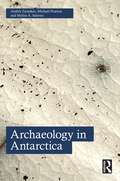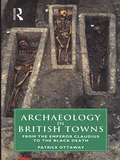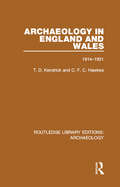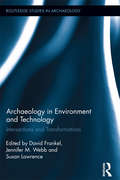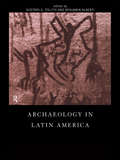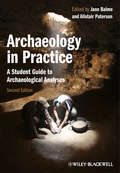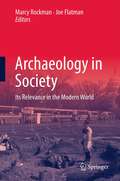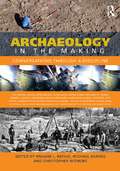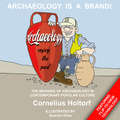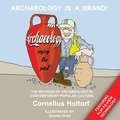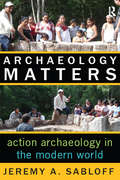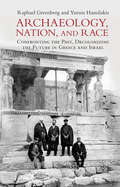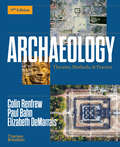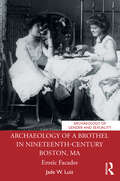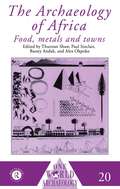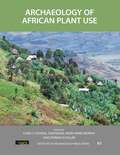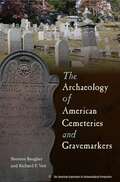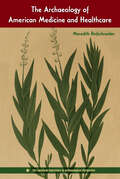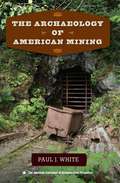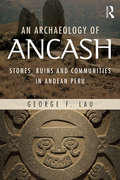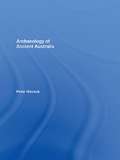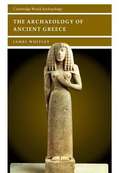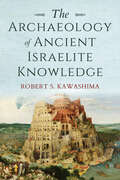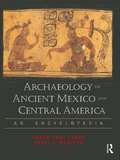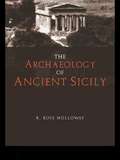- Table View
- List View
Archaeology in Antarctica
by Andres Zarankin Michael Pearson Melisa A. SalernoArchaeology in Antarctica outlines the history of archaeology in the Antarctic and sub-Antarctic. The book details for the first time all past archaeological work in Antarctica, relating to both its use for conservation and research purposes, drawing on published, unpublished and oral information. This work has addressed historic and current scientific bases, explorers’ huts, whaling stations and sealing shelters. The ongoing and long-term research on the sealing shelters and sites in the South Shetland Islands features prominently. The archaeology enables new perspectives on the impact of global modernity and empire in the Antarctic and challenges established dominant discourses on the ‘heroic’ nature of human interaction with the continent. The work on sealing sites gives voice to the experiences of the sealer as a subaltern group previously largely overlooked by historical sources. This book will appeal to students and researchers in archaeology, history and heritage as well as readers interested in the human and historical aspects of Antarctica’s past and present.
Archaeology in British Towns: From the Emperor Claudius to the Black Death
by Patrick OttawayOver the last twenty-five years archaeology has revolutionised our knowledge of the early history of British towns. Based on his day-to-day involvement in urban archaeology, Patrick Ottaway reviews the important discoveries and research themes of this period, and considers how long-term urban research projects have revealed new information about towns and the lives of their inhabitants. The work of the urban archaeologist is examined in close detail, and attention is given to the critical problems of preserving our urban past, especially when the interests of archaeology and property development clash.
Archaeology in England and Wales 1914 - 1931 (Routledge Library Editions: Archaeology)
by C.F.C. Hawkes T.D. KendrickThis survey of work carried out over a number of years synthesises the progress of archaeology, showing at a glance the changes within less than quarter of a century on the interpretation of and reflection on knowledge in the area. Entertainingly, written, this is a lasting introductory account of important finds in English and Welsh archaeology, by two of the key researchers of the time. Heavily illustrated, this book showcases many artefacts as well as maps and plans, offering a wealth of information.
Archaeology in Environment and Technology: Intersections and Transformations (Routledge Studies in Archaeology #8)
by Susan Lawrence David Frankel Jennifer M. WebbEnvironments, landscapes, and ecological systems are often seen as fundamental by archaeologists, but how they relate to society is understood in very different ways. The chapters in this book take environment, culture, and technology together. All have been the focus of much attention; often one or other has been seen as the starting point for analysis, but this volume argues that it is the study of the inter-relationships between these three factors that offers a way forward. The contributions to this book pick up different strands within the tangled web of intersections between environment, technology, and society, providing a series of case studies which explore facets of this common theme in different settings and circumstances and from different perspectives. As well as addressing themes of theoretical and methodological interest, these case studies draw on primary research dealing with time periods from the late Pleistocene glacial maximum to the very recent past, and involve societies of very different types. Running through all the contributions, however, is a concern with the archaeological record and the ways in which scales of observation and availability of evidence affect the development of questions and explanations. The diversity of the chapters in this volume demonstrates the inherent weakness in any attempt to prioritise environment, technology, or society. These three factors are all embedded in any human activity, as change in one will result in change in the others: social and technical changes alter relations with the environment–and indeed the environment itself—and as environmental change drives changes in society and technology. As this book shows, it is possible to consider the relationship between the three factors from different perspectives, but any attempt to consider one or even two in isolation will mean that valuable insights will be missed.
Archaeology in Latin America
by Gustavo G. Politis Benjamin AlbertiThis pioneering and comprehensive survey is the first overview of current themes in Latin American archaeology written solely by academics native to the region, and it makes their collected expertise available to an English-speaking audience for the first time. The contributors cover the most significant issues in the archaeology of Latin America, such as the domestication of camelids, the emergence of urban society in Mesoamerica, the frontier of the Inca empire, and the relatively little known archaeology of the Amazon basin. This book draws together key areas of research in Latin American archaeological thought into a coherent whole; no other volume on this area has ever dealt with such a diverse range of subjects, and some of the countries examined have never before been the subject of a regional study.
Archaeology in Practice: A Student Guide to Archaeological Analyses
by Jane Balme Alistair PatersonThis much-enhanced new edition of the highly accessible guide to practical archaeology is a vital resource for students. It features the latest methodologies, a wealth of case studies from around the world, and contributions from leading specialists in archaeological materials analysis. New edition updated to include the latest archaeological methods, an enhanced focus on post-excavation analysis and new material including a dedicated chapter on analyzing human remains Covers the full range of current analytic methods, such as analysis of stone tools, human remains and absolute dating Features a user-friendly structure organized according to material types such as animal bones, ceramics and stone artifacts, as well as by thematic topics ranging from dating techniques to report writing, and ethical concerns. Accessible to archaeology students at all levels, with detailed references and extensive case studies featured throughout
Archaeology in Society: Its Relevance in the Modern World
by Joe Flatman Marcy RockmanThe practiceof archaeology has many different facets: from academia, to government, tocultural resource management, to public media. Considering the place of archaeology in society means understanding the rolesthat archaeology has in the present day and a sense of the contributions thatit can make in each of these areas, both now and in the future. Archaeologistscome to the field to pursue a variety of interests: teaching, examininghistory, preserving the environment, or studying a specialized time period orinterest. The outside world has a number of other expectations of archaeology:preservation, tourism, and education, to name but a few. From a broad and varied background, the editors have compiled a rare group ofcontributors uniquely qualified to address questions about the current state ofarchaeology and its relevance in society. There is no single answer to thequestion of how the field of archaeology should develop, and what it can do forsociety. Instead,the authors in this volume lay out the many ways in which archaeology isrelevant to the present day - considering, for example, climate change, energyexploration, warfare, national identity, the importance of stories and how theyare told, and how and why opportunities to engage with the past throughmuseums, digs, television, classes, and the print media have the formsthey currently do - creating a state-of-the-art tool for archaeologists, policymakers and the public alike to understand the work of many in the fieldand address the challenges we all face.
Archaeology in the Making: Conversations through a Discipline
by William L. Rathje Michael Shanks Christopher WitmoreArchaeology in the Making is a collection of bold statements about archaeology, its history, how it works, and why it is more important than ever. This book comprises conversations about archaeology among some of its notable contemporary figures. They delve deeply into the questions that have come to fascinate archaeologists over the last forty years or so, those that concern major events in human history such as the origins of agriculture and the state, and questions about the way archaeologists go about their work. Many of the conversations highlight quite intensely held personal insight into what motivates us to pursue archaeology; some may even be termed outrageous in the light they shed on the way archaeological institutions operate – excavation teams, professional associations, university departments.Archaeology in the Making is a unique document detailing the history of archaeology in second half of the 20th century to the present day through the words of some of its key proponents. It will be invaluable for anybody who wants to understand the theory and practice of this ever developing discipline.
Archaeology Is a Brand!: The Meaning of Archaeology in Contemporary Popular Culture
by Cornelius HoltorfWhat impact is there on the field to recognize that archaeology is a regular feature in daily life and popular culture? Based upon the study of England, Germany, Sweden and the USA, Cornelius Holtorf examines the commonalities and peculiarities of media portrayal of archaeology in these countries, and the differences between media presentations and audience knowledge and attraction to the subject, In his normal engaging, populist style, Holtorf discusses the main strategies available to archaeologists in engaging with their popular representations. Possessors of a widely recognized, positively valued and well underpinned brand, archaeologists need to take more seriously the appeal of their work.
Archaeology Is a Brand! The Meaning of Archaeology in Contemporary Popular Culture
by Cornelius HoltorfHoltorf (archaeology, U. of Lund) is objective in his examinations of how the trendiness of archaeology gets in its own way in the media. He examines television shows from Germany, Sweden and Great Britain (with a sideswipe at the newspapers), common perceptions such as "archaeologists dig up things" and the pleasure amateurs take in the discipline, the role of the archaeologist in the mass media (adventurer, detective, maker of profound revelations, and caregiver of ancient sites and finds), the archaeologist's clothes, strategies of engagement with the public (education, public relations and democratic), and the benefits of reconsidering public-view archaeology. Annotation ©2007 Book News, Inc., Portland, OR (booknews.com)
Archaeology Matters: Action Archaeology in the Modern World (Key Questions in Anthropology #1)
by Jeremy A SabloffArchaeology is perceived to study the people of long ago and far away. How could archaeology matter in the modern world? Well-known archaeologist Jeremy Sabloff points to ways in which archaeology might be important to the understanding and amelioration of contemporary problems. Though archaeologists have commonly been associated with efforts to uncover cultural identity, to restore the past of underrepresented peoples, and to preserve historical sites, their knowledge and skills can be used in many other ways. Archaeologists help Peruvian farmers increase crop yields, aid city planners in reducing landfills, and guide local communities in tourism development and water management. This brief volume, aimed at students and other prospective archaeologists, challenges the field to go beyond merely understanding the past and actively engage in making a difference in the today’s world.
Archaeology, Nation, and Race: Confronting the Past, Decolonizing the Future in Greece and Israel
by Raphael Greenberg Yannis HamilakisArchaeology, Nation, and Race is a must-read book for students of archaeology and adjacent fields. It demonstrates how archaeology and concepts of antiquity have shaped, and have been shaped by colonialism, race, and nationalism. Structured as a lucid and lively dialogue between two leading scholars, the volume compares modern Greece and modern Israel – two prototypical and influential cases – where archaeology sits at the very heart of the modern national imagination. Exchanging views on the foundational myths, moral economies, and racial prejudices in the field of archaeology and beyond, Hamilakis and Greenberg explore topics such as the colonial origins of national archaeologies, the crypto-colonization of the countries and their archaeologies, the role of archaeology as a process of purification, and the racialization and 'whitening' of Greece and Israel and their archaeological and material heritage. They conclude with a call for decolonization and the need to forge alliances with subjugated communities and new political movements.
Archaeology (Ninth Edition): Theories, Methods, And Practice
by Colin Renfrew Paul Bahn Elizabeth DeMarraisStill authoritative, now thoroughly updated by new co-author Elizabeth DeMarrais This authoritative survey of archaeological practice takes a unique approach by launching each chapter with an important question that archaeologists consider. In this edition, new co-author Elizabeth DeMarrais, an expert in the archaeology of the Americas, introduces recent discoveries and advances in methodology, analysis, and interpretation, paying special attention to the contributions of women, people of color, and Indigenous communities, and to how the discipline is changing amid calls for decolonization and diversification.
Archaeology of a Brothel in Nineteenth-Century Boston, MA: Erotic Facades (Archaeology of Gender and Sexuality)
by Jade W. LuizArchaeology of a Brothel in Nineteenth-Century Boston, MA provides an accessible and thought-provoking account of the archaeological understanding of nineteenth-century prostitution in Boston, Massachusetts. The book explores how the practice of nineteenth-century sex work involved a careful construction of fantasy for brothel customers. This fantasy had the potential to provide financial stability and security for the madam of the establishment, if not for the women working for them. Employing theories of embodiment, sexuality, and an archaeology of the senses, this study of the Endicott Street collection contributes a new methodological and theoretical framework for studying the archaeology of prostitution across time, space, and culture. The material culture recovered from brothel sites allows exploration of both the semi-private, "behind the scenes" narrative of sex work, as well as the semi-public, eroticised "performance space" where patrons were entertained. Few books on the archaeology of sex work exist and this volume will both provide an updated perspective on the history of sex work in Boston in the nineteenth century as well as tie advances in gender and embodiment theories to a compelling case study. The book is for students and scholars of historical archaeology, nineteenth-century urban America, and gender studies. Students studying feminist theory and archaeology of the senses will also be interested in the contents.
The Archaeology of Africa: Food, Metals and Towns (One World Archaeology #Vol. 20)
by Thurstan Shaw Paul Sinclair Bassey Andah Alex OkpokoAfrica has a vibrant past. It emerges from this book as the proud possessor of a vast and highly complicated interweaving of peoples and cultures, practising an enormous diversity of economic and social strategies in an 2xtraordinary range of environmental situations. At long last the archaeology of Africa has revealed enough of Africa's unwritten past to confound preconceptions about this continent and to upset the picture inferred from historic written records. Without an understanding of its past complexities, it is impossible to grasp Africa's present, let alone its future.
Archaeology of African Plant Use (UCL Institute of Archaeology Publications #61)
by Chris J. Stevens Sam Nixon Mary Anne Murray Dorian Q FullerThe first major synthesis of African archaeobotany in decades, this book focuses on Paleolithic archaeobotany and the relationship between agriculture and social complexity. It explores the effects that plant life has had on humans as they evolved from primates through the complex societies of Africa, including Egypt, the Buganda Kingdom, southern African polities, and other regions. With over 30 contributing scholars from 12 countries and extensive illustrations, this volume is an essential addition to our knowledge of humanity’s relationship with plants.
The Archaeology Of American Cemeteries And Gravemarkers (American Experience In Archaeological Pespective Ser.)
by Sherene Baugher Richard Veit“A masterful overview of archaeological work on American gravestones and cemeteries that should be on the shelf of every student and scholar of mortuary studies.”—Lynn Rainville, author of Hidden History: African-American Cemeteries in Virginia “A landmark publication that synthesizes for the first time the massive amount of research on historic mortuary archaeology, especially monuments, across America. An essential text for many archaeologists, art historians, and cultural anthropolgists.”—Harold Mytum, coeditor of Prisoners of War: Archaeology, Memory, and Heritage of 19th- and 20th-Century Mass Internment
The Archaeology of American Medicine and Healthcare (The American Experience in Archaeological Perspective)
by Meredith ReifschneiderExamining the dynamic histories of medical practice in the United States through the lens of historical archaeology In this book, Meredith Reifschneider synthesizes archaeological research on healthcare and medicine to show how practices in the United States have evolved since the nineteenth century. Tracing the areas of medical science and healthcare professionalization, alternative medicine, healthcare consumerism, and public health reform, Reifschneider shows how historical archaeology—which draws on information from the material record, archival sources, historical documents, and ethnographic research—can provide important insights into healthcare and modes of self-care in the past. Reifschneider analyzes archaeological evidence uncovered from sites such as house deposits, middens, latrines, and hospital waste pits that demonstrates how official healthcare policies were implemented in daily life, revealing a diversity of therapeutic practices connected to social identities. The book includes a case study of the US Army’s hygiene and healthcare practices at the Presidio of San Francisco, showing how soldiers engaged in practices mandated by the government while also using alternative therapies for self-care. Throughout the book, Reifschneider highlights structural health inequalities in the past and how the effects of previous exclusionary policies continue to manifest in the present day. By examining healthcare and medicine through the lens of archaeology, this book demonstrates the dynamic and often unexpected histories of medical practice, pointing to the ways Americans’ experiences today reflect these historical dynamics. A volume in the series the American Experience in Archaeological Perspective, edited by Michael S. Nassaney and Krysta Ryzewski
The Archaeology of American Mining (The American Experience in Archaeological Perspective)
by Paul J. WhiteMining History Association Clark C. Spence Award The mining industry in North America has a rich and conflicted history. It is associated with the opening of the frontier and the rise of the United States as an industrial power but also with social upheaval, the dispossession of indigenous lands, and extensive environmental impacts. Synthesizing fifty years of research on American mining sites that date from colonial times to the present, Paul White provides an ideal overview of the field for both students and professionals. The Archaeology of American Mining offers a multifaceted look at mining, incorporating findings from an array of subfields, including historical archaeology, industrial archaeology, and maritime archaeology. Case studies are taken from a wide range of contexts, from eastern coal mines to Alaskan gold fields, with special attention paid to the domestic and working lives of miners. Exploring what material artifacts can tell us about the lives of people who left few records, White demonstrates how archaeologists contribute to our understanding of the legacies left by miners and the mining industry. A volume in the series the American Experience in Archaeological Perspective, edited by Michael S. Nassaney
An Archaeology of Ancash: Stones, Ruins and Communities in Andean Peru
by George LauAn Archaeology of Ancash is a well–illustrated synthesis of the archaeology of North Central Peru, and specifically the stone structures of the Ancash region. All the major cultures of highland Ancash built impressive monuments, with no other region of South America showing such an early and continuous commitment to stone carving. Drawing on Lau’s extensive experience as an archaeologist in highland Peru, this book reveals how ancient groups of the Central Andes have used stone as both a physical and symbolic resource, uncovering the variety of experiences and meanings which marked the region’s special engagement with this material. An abundant raw resource in the Andes, stone was used for monuments, sculptures and other valuables such as carved monoliths, which were crucial to the emergence of civilization in the region, and religious objects from magical charms to ancestor effigies. Detailing the ways stone has played both an everyday and an extraordinary part in ancient social life, Lau also examines how cultural dispositions towards this fundamental material have changed over time and considers how contemporary engagements with these stone remains have the potential to create and regenerate communities. With an ample selection of color photos which bring these sites and artifacts to life, An Archaeology of Ancash is an essential guide to the key monuments, places and objects that distinguish this region and its rich archaeological heritage.
Archaeology of Ancient Australia
by Peter HiscockThis book is an introduction to the archaeology of Australia from prehistoric times to the eighteenth century AD. It is the only up-to-date textbook on the subject and is designed for undergraduate courses, based on the author's considerable experience of teaching at the Australian National University. Lucidly written, it shows the diversity and colourfulness of the history of humanity in the southern continent. The Archaeology of Ancient Australia demonstrates with an array of illustrations and clear descriptions of key archaeological evidence from Australia a thorough evaluation of Australian prehistory. Readers are shown how this human past can be reconstructed from archaeological evidence, supplemented by information from genetics, environmental sciences, anthropology, and history. The result is a challenging view about how varied human life in the ancient past has been.
The Archaeology of Ancient Greece (Cambridge World Archaeology)
by James Whitley Norman Yoffee Susan Alcock Tom Dillehay Stephen Shennan Carla SinopoliThe Archaeology of Ancient Greece provides an up-to-date synthesis of current research on the material culture of Greece in the Archaic and Classical periods. Its rich and diverse material has always provoked admiration and even wonder, but it is seldom analyzed as a key to our understanding of Greek civilization. Dr. Whitley shows how the material evidence can be used to address central historical questions for which literary evidence is often insufficient, and he also situates Greek art within the broader field of Greek material culture.
The Archaeology of Ancient Israelite Knowledge (Biblical Literature)
by Robert S. KawashimaThe Archaeology of Ancient Israelite Knowledge reconstructs in carefully researched detail the worldview of the ancient Israelites writers responsible for the Hebrew Bible. What was the role of God in their lives? How did they see the relationship between God, nature, and themselves? Contrary to prevailing scholarly understanding, Robert Kawashima argues that the ancient Israelites saw God in a radically different way than the peoples around them. God no longer interconnected everything—humans, nature—but became seen as sharply separated from nature.Elegantly written and powerfully argued, The Archaeology of Ancient Israelite Knowledge is essential reading for anyone wanting to grasp the Hebrew Bible and the ancient world that gave rise to it.
Archaeology of Ancient Mexico and Central America: An Encyclopedia
by Susan Toby Evans David L. WebsterThis is the first comprehensive, one-volume encyclopedia in English devoted to pre-Columbian archaeology of the Mesoamerican culture area. In more than 500 articles by the major experts in the field, this work brings the most recent scholarship to an examination of regional environments and their cultural evolution. Entries range from the familiar
The Archaeology of Ancient Sicily
by R. Ross HollowayFirst Published in 2004. Routledge is an imprint of Taylor & Francis, an informa company.
